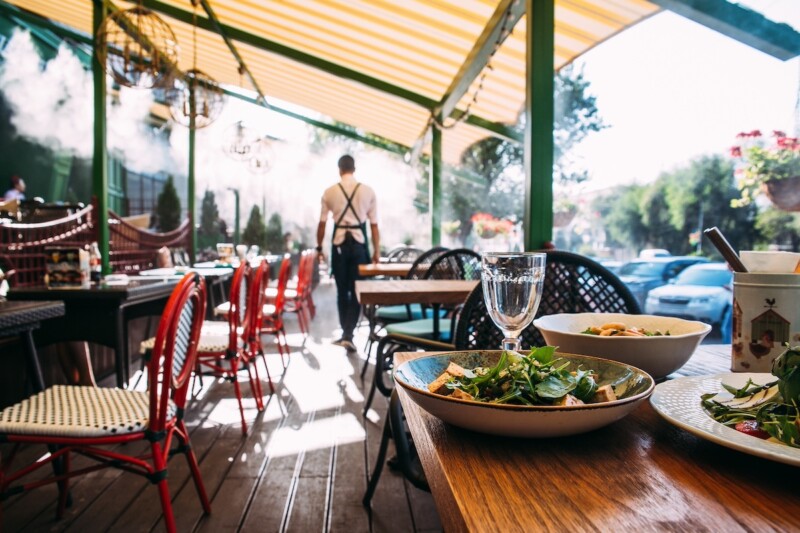When a revamped Johnny Rockets opened for business at Destiny USA mall, Syracuse, N.Y., the joint was so jumpin’ that owners had to order 18 new chairs and five extra tables during grand opening week to accommodate crowds. Guests were curious to see Johnny Rockets’ new look as well as enjoy the Lake Forest, Calif., chain’s classic diner menu of burgers, fries and hand-spun shakes.
But for Johnny Rockets franchisees, the big news lies in the metrics coming out of the (now) 86-seat Syracuse store: burgers finished in a third of the time, shakes in half the time, smart fryers, a more efficient kitchen—and double-digit sales increases.
Johnny Rockets’ Syracuse store, dubbed “2.0,” combines design flexibility that will help franchisees remodel, build and open new restaurants with smaller footprints and in nontraditional venues.
“We wanted to modernize Johnny Rockets while retaining the core elements that make up our 30-year-old brand,” says James Walker, President of Operations and Development. Johnny Rockets has made its name with a 1950s diner look, jukeboxes, servers dressed in the classic soda fountain uniforms as well as its original burgers and shakes.
“Our goals were to create a more competitive footprint by re-engineering the kitchen, speeding food production, increasing quality and consistency and re-deploying labor dollars,” he adds.
The idea for the Johnny Rockets prototype got its spark from a drive-thru makeover. “We were looking for ways to speed up window service using Taylor clamshell griddles [vs. conventional open griddles],” says Dominic Talavera, V.P. Design and Construction. “Once we assembled the equipment and [started recording faster service times], the lightbulb went off.”
Johnny Rockets 2.0 was the result of a cross-functional team, including leaders from the company’s Operations, Design and Construction departments. The five key people who most worked on the kitchen makeover include Walker as team leader, Talavera, Jim Hicks, Senior V.P. Operations, Jim Kensinger, V.P. Operation Services, and Mike Chico, Manager of Design.
Open, Fast Kitchen
New Johnny Rockets stores will range from 700 sq. ft. to 3,500 sq. ft. in size depending on location, but for all new stores, the redesign has compressed the kitchen footprint while speeding operations. Size-wise, the Johnny Rockets 2.0 kitchen will be roughly 20% smaller than existing kitchens.
Cost-wise, the pricier clamshell griddle raised the equipment package tally to between $175,000 and $185,000, up from between $155,000 and $165,000 for previous models. “The added speed of service should result in payback in less than a year,” Talavera says. “Our new high-efficiency kitchen is all about building sales rather than saving on costs. And because we were able to find cost savings in other areas, the prototype is essentially cost-neutral.”
Workers will benefit from the increased efficiencies, too. “Johnny Rockets’ team members are a critical component of the restaurant experience,” Walker adds. “By reducing production times, we’re giving staff more time to interact with guests.”
While the cookline layout has stayed the same, the equipment package underwent significant upgrades. Custom-designed clamshell griddles, with heated cooking surfaces that grill burgers from the top and bottom simultaneously, serve as the new cookline linchpin, supported by high-efficiency fryers and the shake station.
“We worked with Taylor to begin testing a clamshell griddle in 2015,” Talavera says. “Their regular clamshells worked well cooking burger patties but they weren’t quite heavy enough to flatten Johnny Rockets’ hamburger ‘pucks.’ Taylor came back to us with a heavier platen that was able to smash pucks into our signature irregular patty shape.”
As a result of double-sided cooking, burger production times clock in at 60 seconds, down from three-and-a-half minutes using conventional open griddles. “Not only have we nearly tripled our speed—quality and consistency have increased as well,” Talavera says.
The 42-in.W, three-platen clamshell griddle (vs. the 72-in.W griddle used in existing locations) has allowed a smaller hood, too. “Some stores, however, might add a 2-ft. or 3-ft. regular griddle for extra menu items,” Talavera says.
Crew members use a Prince Castle vertical toaster to toast buns. The unit both saves space on the grill and helps cooks keep up with faster burger cook times.
For the fryers, “We worked with Henny Penny (plus took a factory tour and performed extensive testing) to select the Elite model,” Talavera says. The fryers make life easier for staffers thanks to automatic oil top-off to maintain oil levels and quality, pre-programmed fry times and automatic self-filtering.
Shake-station upgrades came from changing the ice cream base. The team was able to save valuable prep time by switching to a tempered (i.e. slightly softened) ice cream base dispensed from a machine rather than hand-scooping hardfrozen ice cream. The shake machine, a Taylor JR490 unit, was engineered to make a thicker shake than the standard 490 unit. Staffers still rely on a five-spindle mixer to blend the ice cream, syrups and mix-ins, but the time to make shakes has reduced from 68 seconds to 38 seconds per shake.
“It was critical to our brand that we continue to hand-spin shakes to order rather than taking any shortcuts,” Walker says. “The new ice cream dispenser makes it easier to portion, and thanks to a higher butter-fat content and better sweeteners, we’ve improved quality, too. Today, there’s no need for a dipping cabinet and workers don’t need to walk back to the freezer to restock ice cream.” Instead, the base mix comes frozen in bags and is kept in an undercounter refrigeration unit, which is stocked by employees a couple times a day.
Last—but hardly least—technology in the form of a kitchen display system has replaced paper tickets and printers at Johnny Rockets 2.0. Flat-screen monitors positioned at the griddles and fryers have helped increase ticket times.
Front-Of-House 2.0
Johnny Rockets’ new front-of-house look, shaped with input from branding and design firm WD Partners, Dublin, Ohio, echoes its ’50s diner heritage but adds a retro-modern spin meant to appeal to millennials, Hispanic customers and families.
The restaurant’s color theme is still classic diner—black and white with red accents—but now wood planking and white brick set the stage. Lighting comes from glass globes and industrial-style caged pendants with red accents. Accent walls are filled with “freshness cues”—block-letter words such as “fresh,” “never frozen” and “farm to table.”
In a move away from all-booth seating, Johnny Rockets 2.0 uses a combination of two-top and four-top tables, a six-top communal table and bright red chairs as well as booth and counter seating.
“We gave special consideration to the seating in the redesign,” Walker says. “We wanted to maintain some of the elements of the classic diner including counter seating. Now, we can accommodate different size groups with the new design as tables and chairs can easily be moved.”
Johnny Rockets’ Syracuse prototype is testing one technology upgrade in the form of a self-service order kiosk positioned at the restaurant entrance. “In surveys, our guests have requested this type of technology,” Walker says. “Millennial consumers love the ability to customize their burger order—this lets them create something unique and special.”
“Guests can use the kiosk for to-go orders, then head to the pickup area of the counter to pay,” Walker says. “There’s no need for them to stand in line with guests waiting for tables.”
Also on the technology front, Johnny Rockets is in the process of revamping its website, developing a mobile app and updating its social media platforms.
A Look Ahead
“Existing franchise locations will begin phasing in 2.0’s design elements over the next year,” Walker says. As for new builds, the company expects to open 15 new restaurants in the 2.0 design by December, and all new international locations will adopt the new design.
The 2.0 design also will be part of Johnny Rockets’ limited-seating drive-thru units and its express locations in theme parks, airports and other host venues (where the menu is limited and the platform is pay-first). In June, the first drive-thru opened in Mooresville, N.C., and an express unit will open in Tucson, Ariz., in July.
SPECS
MENU/SEGMENT: Fast-casual burgers
HEADQUARTERS: Lake Forest, Calif.
FOUNDED: 1986
NUMBER OF UNITS: More than 350 restaurants in 28 countries
SIZE: 700 sq. ft. to 3,500 sq. ft.
EQUIPMENT PACKAGE: $180,000
2016 PLANS: 70 openings system wide
INTERIOR DESIGN FIRM: WD Partners, Dublin, Ohio
DEALER: Grand Hockenbergs, Plymouth, Minn.
ADDITIONAL DEALER PARTNERS: C&T Design and Equipment, Concept Services, Edward Don, Myers Restaurant Supply and TriMark
WEB: johnnyrockets.com
EQUIPMENT
Back-Of-House
John Boos work table, shelving
Ice-O-Matic/Ali Group pearl ice maker, bin
Jackson door-type warewasher
CaptiveAire condensate hood
Imperial Brown walk-in cooler/freezer
Cookline
Taylor/United Technologies contact griddle with platens
Henny Penny fryer bank with filters
Merco/Manitowoc French fry warmer, fried-food holding station
APW Wyott/Standex cooker/warmer, hot well (single)
Gehl’s melted cheese dispenser
CaptiveAire exhaust hood
Delfield/Manitowoc undercounter refrig.
Aloha System by SDCR/NCR kitchen display system
Prince Castle/Marmon vertical toaster
True refrig. sandwich/salad prep table
Shake Station
Craft Mfg. custom stainless fabrication
Nelson ice cream station
Taylor/United Technologies shake machine
Sterling Multimixer 5-spindle mixer
Delfield/Manitowoc undercounter freezer
T&S Brass dipperwell
RELATED CONTENT
- Advertisement -
- Advertisement -
- Advertisement -
TRENDING NOW
- Advertisement -
- Advertisement -
- Advertisement -


